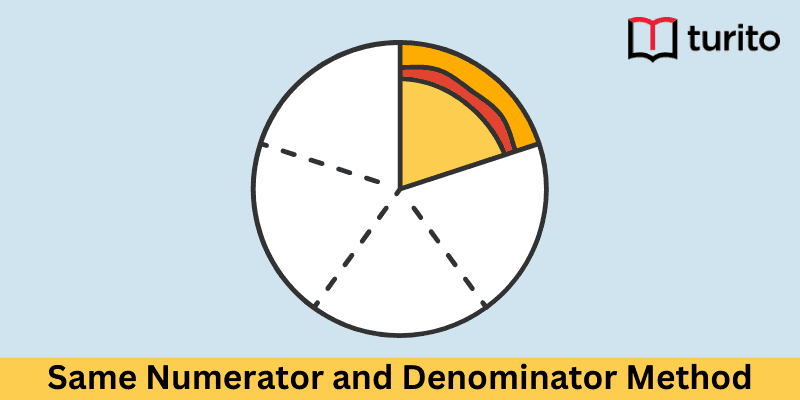Key Concepts
- Use models to compare fractions: Same Denominator
- Use models to compare fractions: Same Numerator
Introduction:
The same denominator method
- The denominator is the bottom number in a fraction.
- It shows how many equal parts the item is divided.
When two fractions have the same denominator, they are easy to compare:
For instance, 4/9 is less than, 5/9 (because 4 < 5)

4/9 is 4 times the unit fraction 1/9
5/9 is 5 times the unit fraction 1/9
Draw 𝟏/𝟗 strips,

Here, we can observe that denominators are the same in both fractions.
So, we must compare numerators.
Numerator 4 is less than 5 (4 < 5)
∴4/9 is less than 5/9

Comparison using symbols: 4/9 < 5/9
Example
Which is greater, 3/6 or 2/6 ?

3/6 is 3 of the unit fraction 1/6
2/6 is 2 of the unit fraction 1/6
So, 3/6 is greater than 2/6

Comparison using symbols: 3/6 > 2/6
Real-life Example
A Pizza was divided into three equal parts (slices).

In the diagram, the whole is represented with the fraction 3/3
If you take out one part, the remaining portion represents 2/3
In this example, both denominators are the same, so we must compare numerators.
The numerator 3 is greater than 2.
∴ 3/3 is greater than 2/3.
Using 𝟏/𝟑 strips:

Comparison using symbols: 3/3 > 2/3
13.4 Use models to compare fractions: Same Numerator
Look at the models

They each have 1 piece shaded in. So, all we have to compare is the size of each piece
Which pie has the largest shaded part?
- The pie which is partitioned into halves
- The denominator with the smallest number gives you the biggest size pieces
Comparison using symbols:
1/2 > 1/4 > 1/6
What happens to the denominator as your pieces get smaller?
- The number in the denominator gets bigger
- The same numerator is equal to the same number of pieces being referred to
- So, if the fractions refer to the same whole, and the numerators are the same, then the number of pieces being compared is the same.
Example
Tom and Jerry each made a pie. The pies were the same size. Tom cut his pie into 8 slices; Jerry cut his into 6 slices. They each ate 2 slices of their own pie. Who ate more?
Draw a model. Write the fraction that each ate

Did they eat the same number of pieces?
Are the numerators the same?
We use fraction strips to compare the size of the pieces or compare the denominators.

Sixths are bigger than eighths, so
2/6 is bigger than 2/8.
So, Jerry ate more pie.
Comparison using symbols: 2/6 > 2/8
Exercise:
- Rani reads 1/6 of a book in the morning; she reads 4/6 of the book in the afternoon. What fraction of the book does she read?
- What is the equivalent fraction of 3/4 with denominator 20?
- Raj has 26 toffees. He gave one-half to his friend. How many toffees did he give to his friend?
- Write two comparison statements about the fractions shown below.

5. Which is greater ¼ or 1/6 ? Draw fraction strips to complete the diagram and answer the question.

6. Maria and Nina each ordered a small pizza. Maria ate 3/8 of her pizza. Nina ate 3/6 of her pizza. Who ate more pizza?
7. Explain Why is 1/6 greater than 1/8 but less than 1/3?
8. Two pizzas were each cut into sixths. Ashraf, Drew, and Katie shared the pizzas equally. How many sixths did each friend get?
9. Eric and Frank want to share 4/3 feet of rope equally. What length of rope should each friend get? Explain how to use a drawing to help solve the problem.
10. Ronald spent the day making a painting for his friend. At the end of the day, Ronald finished ¼ of the painting. If he is able to finish as much of a painting each day he works, how long will it take Ronald to make 2 whole paintings?
What we have learned:
- How to compare fractions that refer to the same-sized whole and have the same denominator by comparing their numerators
- How to compare fractions that refer to the same-sized whole and have the same numerator by comparing their denominators
- How to use symbols (>, <, =) to compare fractions with different numerators and denominators
- Recognize that to compare two fractions both must refer to the same whole
- How to draw area models to compare two fractions
- How to compare fractions that refer to the same-sized whole and have the same denominator by comparing their numerators
- How to compare fractions that refer to the same-sized whole and have the same numerator by comparing their denominators
- How to use symbols (>, <, =) to compare fractions with different numerators and denominators
- Recognize that to compare two fractions both must refer to the same whole
- How to draw area models to compare two fractions
Concept Map










Comments: